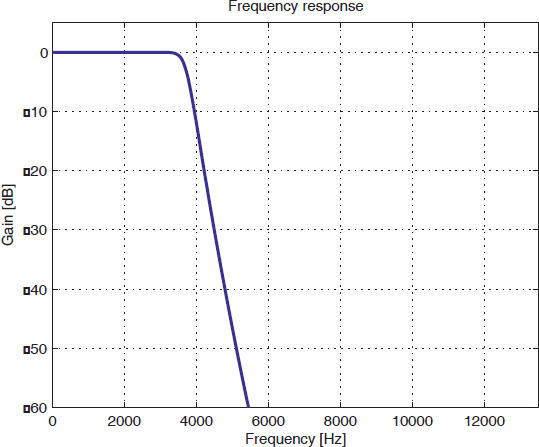7.2. Solved exercises
EXERCISE 7.1.
Define in the Laplace domain the transfer function of an anti-aliasing filter, which attenuates with 0.5 dB at the frequency vp = 3,500 Hz and with 30 dB at the frequency va = 4,500 Hz.
Fp = 3500;Fs = 4500;
Wp = 2*pi*Fp; Ws = 2*pi*Fs;
[N, Wn] = buttord(Wp, Ws, 0.5, 30,'s');
[b,a] = butter(N, Wn, 's');
wa = 0: (3*Ws)/511:3*Ws;
h = freqs(b,a,wa) ;
plot (wa/(2*pi), 20*log10(abs(h))) ;grid
xlabel('Frequency [Hz]');
ylabel('Gain [dB]');
title('Frequency response');
axis ([0 3*Fs -60 5]) ;

Figure 7.4. Frequency response of an analog Butterworth lowpass filter
EXERCISE 7.2.
Consider a system with the impulse response h[n] = 0.9n. Plot the impulse response of this system sampled at 1 Hz for values of n between 0 and 50. Demonstrate that its time constant is equal to 10.
n=[0:50]; h=(0.9) .^n;
subplot(211); stem(n,h)
grid; xlabel('n'); ylabel('h(n)')
title('Impulse response')
hI=exp(-n/10);
subplot (212)
plot (n,h1, '+',n,h,'-r')
grid; xlabel('n') ;
legend('exp(-n/10)', 'h(n)')

Figure 7.5. Impulse response of the system from exercise 7.2
The system indicial response can be calculated using the function cumsum.m. The transfer function has a zero in 0 and a pole in 0.9. The impulse and indicial responses can also be calculated using the function filter.m ...
Get Digital Signal Processing Using Matlab now with the O’Reilly learning platform.
O’Reilly members experience books, live events, courses curated by job role, and more from O’Reilly and nearly 200 top publishers.

